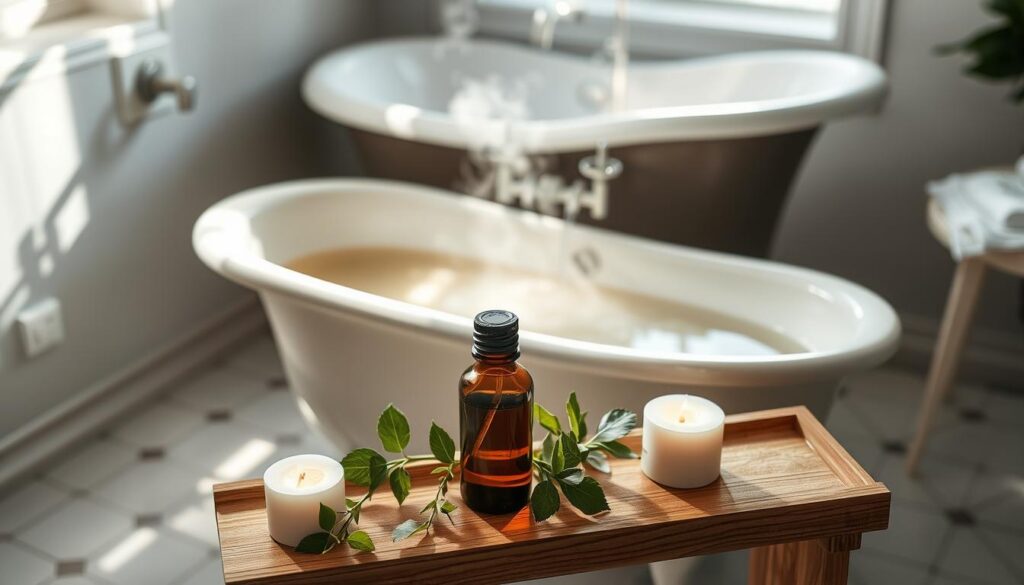Have you ever had to deal with the itch, redness, and discomfort of a vaginal yeast infection? You’re not alone. About 75 percent of people with vaginas will get a yeast infection at some point. Many are looking for natural ways to handle this common problem.
That’s where the sitz bath comes in. It’s a simple, yet effective, way to ease the symptoms of a yeast infection.
Key Takeaways
- Sitz baths with baking soda, apple cider vinegar, tea tree oil, or herbal infusions can help alleviate yeast infection symptoms
- These natural remedies have antifungal and antimicrobial properties that may help slow the growth of Candida fungus
- Sitz baths can provide relief from irritation, itching, redness, swelling, and discharge associated with vaginal yeast infections
- Sitz baths should not replace medical treatment, but can be a complementary approach to manage symptoms
- Regular sitz baths may be especially helpful for those with recurring or chronic yeast infections
What is a Yeast Infection?
A yeast infection, also known as vaginal candidiasis or genital thrush, is a common fungal infection. It affects the vagina and vulva. It’s caused by an overgrowth of Candida albicans, a fungus that’s naturally in the vagina. Yeast infections happen for many reasons. Knowing the symptoms is key to getting the right treatment.
Causes and Symptoms of Vaginal Yeast Infections
Several factors can lead to a vaginal yeast infection. These include:
- Taking antibiotics, which can upset the natural balance of bacteria in the vagina
- Increased warmth and moisture in the genital area
- Douching or using scented feminine hygiene products
- Certain sexual practices
- Genetic predisposition or a weakened immune system
The most common symptoms of a vaginal yeast infection, also known as vulvar candidiasis, are:
- Itching, redness, and swelling in the vagina and vulva
- Thick, white, cottage cheese-like discharge
- Burning sensation during urination or sexual intercourse
If you think you have a yeast infection, see a doctor. The symptoms can be like other, more serious infections. Your healthcare provider can do a simple exam. They can then prescribe the right treatment to help your symptoms and get your vaginal health back.
“Nearly 1.4 million American women seek medical advice for a yeast infection each year.”
Benefits of Sitz Bath for Yeast Infections
If you’re dealing with a yeast infection, a sitz bath can help. It uses ingredients with antifungal and antimicrobial properties. These help soothe vaginal discomfort and alleviate yeast infection symptoms.
Sitz baths slow the growth of Candida fungus, the main cause of these infections. They create a healing environment. This helps reduce inflammation and natural relief for the irritation and itching that come with yeast infections.
While sitz baths shouldn’t replace medical treatment, they can help manage yeast infections. By adding soothing and antimicrobial ingredients, you can get natural relief for yeast infection. This can make a big difference during a tough time.
| Ingredient | Benefits for Yeast Infections |
|---|---|
| Baking Soda | Helps balance pH levels, reduce inflammation, and soothe irritation. |
| Apple Cider Vinegar | Possesses antifungal properties that can inhibit Candida growth. |
| Tea Tree Oil | Has antimicrobial and anti-inflammatory effects, providing relief for discomfort. |
| Herbal Infusions | Certain herbs, such as chamomile and calendula, can have soothing and healing effects. |
By adding these ingredients to a sitz bath, you can actively manage yeast infection symptoms. This can lead to natural relief from discomfort.
“Sitz baths can be a game-changer for women dealing with the unpleasant symptoms of a yeast infection. The natural, soothing properties of these baths can provide much-needed relief and support the body’s natural healing process.”
sitz bath for yeast infections
If you’re dealing with a yeast infection, a sitz bath can help. It involves sitting in a shallow tub with warm water and special ingredients. These can be baking soda, apple cider vinegar, tea tree oil, or herbal infusions like chamomile and thyme.
Do a sitz bath after cleaning yourself and once or twice a day for 15-20 minutes. It can help soothe and heal, but don’t forget any medical treatment your doctor prescribed.
Here’s how a sitz bath can help with yeast infections:
- The warm water increases blood flow and reduces inflammation.
- Ingredients like baking soda and tea tree oil fight the Candida fungus.
- Herbal infusions add soothing and healing properties.
While sitz baths are helpful, always talk to a healthcare provider about a yeast infection. They can help you find the right treatment.
“Sitz baths can provide natural relief and support the body’s natural healing process, but they should not replace prescribed medical treatment for a yeast infection.”
Adding a sitz bath to your yeast infection care can be soothing. But, remember to use it with any medical treatment your doctor gave you. This way, you can manage your yeast infection naturally and keep your vaginal health in check.
Baking Soda Sitz Bath
How to Prepare and Use
A baking soda sitz bath is a natural way to treat yeast infections. It reduces vaginal acidity, stopping fungal growth. It also eases itching and irritation.
To make a baking soda sitz bath, mix 4 tablespoons of baking soda with 2 liters of warm water. Soak for 15-20 minutes, twice a day, until symptoms go away. But, avoid it if you’re pregnant, breastfeeding, or have certain health issues.
Studies show baking soda kills Candida cells, which cause yeast infections. A 2021 study found it effective. Older research from 2012 also supports its antifungal properties.

Baking soda baths help with more than yeast infections. They can ease UTI symptoms and soothe eczema, poison ivy, and chickenpox. They even help with constipation.
If you have a yeast infection, try a baking soda sitz bath. It’s a gentle, natural way to find relief. Just remember to follow the right steps for the best results.
Apple Cider Vinegar Sitz Bath
An apple cider vinegar (ACV) sitz bath is a natural way to ease yeast infection symptoms. ACV has acids that fight off harmful bacteria and fungi. This can help with itching, discharge, redness, and swelling in a vaginal yeast infection.
To make an apple cider vinegar sitz bath, mix 4 tablespoons of ACV with 2 liters (about 0.5 gallons) of warm water. Sit in it for 20 minutes every day. But, pregnant women should not use this sitz bath.
Studies show ACV can stop Candida, the fungus that causes yeast infections, from growing. A 2018 study found ACV can prevent Candida growth in lab tests. Also, a 2015 study showed ACV can kill a Candida strain linked to denture stomatitis as well as nystatin.
Even though ACV looks promising for treating vaginal thrush, more research is needed. If symptoms last more than a week, see a doctor. This is because other conditions might have similar symptoms.
“ACV has been scientifically proven to have antifungal properties, inhibiting the growth of Candida in laboratory research studies.”
Apple cider vinegar sitz baths are usually safe with few side effects. But, drinking too much ACV can hurt your throat and teeth. For people with diabetes who get yeast infections often, ACV might be a good addition to their treatment plan. They could also try coconut oil or prescription antifungal meds.
Tea Tree Oil Sitz Bath
Looking for a natural way to ease yeast infection discomfort? A tea tree oil sitz bath might help. Tea tree oil is known for its strong antifungal and antiseptic powers. It’s often used to treat vulvar candidiasis symptoms.
To make a tea tree oil sitz bath, mix 5 drops of pure tea tree oil with 1 liter (about 4 cups) of warm water. Soak in it for 20 minutes daily, after cleaning your genital area. Tea tree oil can help reduce itching, burning, and irritation from yeast infections.
However, pregnant women should avoid tea tree oil sitz baths. The safety of this oil during pregnancy is still unknown. Also, stop using it if you feel more discomfort or irritation. Always talk to your doctor before trying a tea tree oil sitz bath for a yeast infection.
| Ingredient | Quantity |
|---|---|
| Tea tree oil | 5 drops |
| Warm water | 1 liter (4 cups) |
While tea tree oil sitz baths can offer natural relief, they shouldn’t replace medical treatment. If your symptoms don’t get better or get worse, see a healthcare professional. They can give you the right diagnosis and treatment.

“Tea tree oil has shown potent activity against drug-resistant strains of candida in vitro studies.”
Herbal Sitz Baths
There are more ways to treat yeast infection symptoms than just baking soda, apple cider vinegar, and tea tree oil. Herbal sitz baths can offer natural relief. A chamomile sitz bath is one such option. Chamomile tea has antifungal and antimicrobial properties.
To make a chamomile sitz bath, steep 3 tablespoons of dried chamomile leaves in 1 liter (about 4 cups) of water for 10 minutes.
Another good choice is a thyme and rosemary sitz bath. Both herbs have antifungal compounds like thymol and carvacrol. This natural antifungal sitz bath can soothe irritation and help with healing.
Even though herbal sitz baths are helpful, be careful. Some herbs might not be safe for pregnant or breastfeeding women. Always talk to a healthcare professional before trying new remedies.
“Sitz baths can be a soothing and effective way to find relief from the discomfort of a yeast infection. By incorporating the right herbs, you can take advantage of their natural antifungal and anti-inflammatory properties.”
When it comes to herbal sitz baths for yeast infections, you have many options. From the classic chamomile sitz bath to the aromatic thyme and rosemary sitz bath, these natural remedies can be gentle and effective. Always check with a healthcare professional before trying any new treatment. Enjoy the soothing benefits of these natural antifungal sitz baths.
Conclusion
Sitz baths made with baking soda, apple cider vinegar, tea tree oil, or herbal infusions can help with vaginal yeast infection symptoms. These baths use the antifungal and antimicrobial properties of their ingredients. They help slow Candida fungus growth, reduce inflammation, and ease discomfort.
While sitz baths shouldn’t replace medical treatment, they can be a good addition to managing yeast infection symptoms. Using these natural remedies for vaginal yeast infections can offer relief and support your vaginal health. The summary of sitz baths for yeast infections shows they are effective as complementary treatments for candidiasis.
Sitz baths are a cost-effective and easy way to tackle yeast infection discomfort. By taking a holistic approach and combining these natural remedies with medical treatment, you can find comfort again. This approach promotes your overall vaginal wellness.

